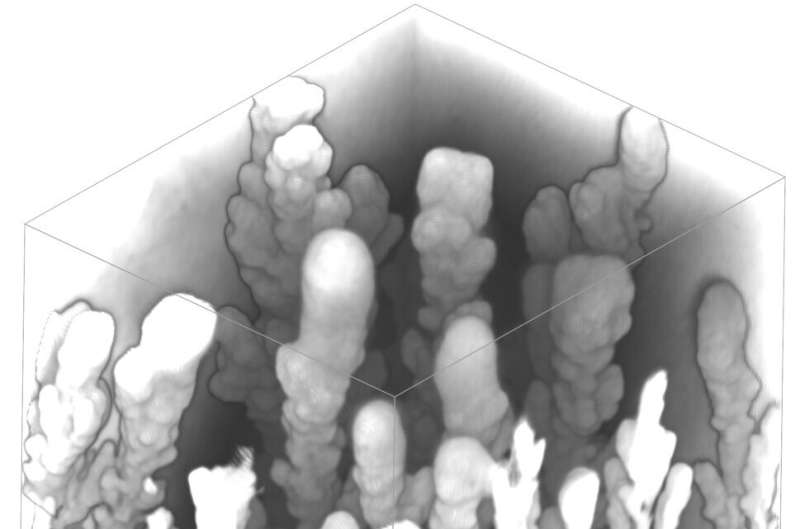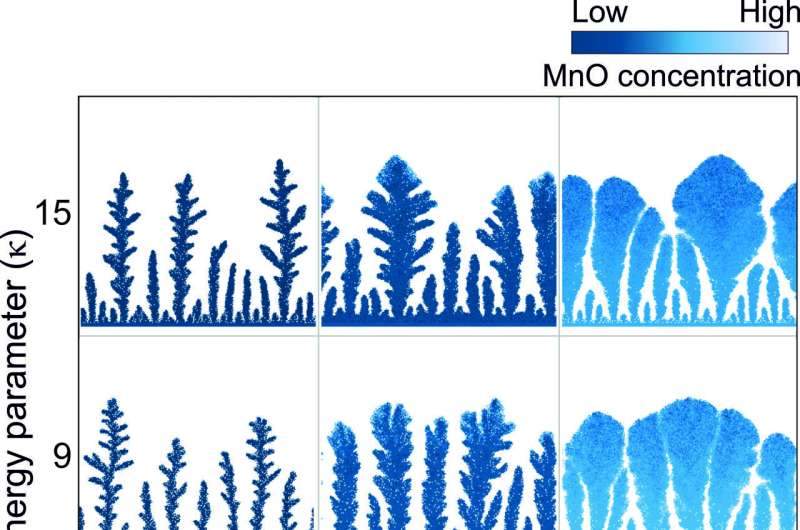This article has been reviewed according to Science X's editorial process and policies. Editors have highlighted the following attributes while ensuring the content's credibility:
fact-checked
peer-reviewed publication
trusted source
proofread
Unraveling the hidden growth of mineral dendrites

An international research team involving scientists from the University of Vienna, the Faculty of Physics of the University of Warsaw and University of Edinburgh has described the process of growing three-dimensional manganese dendrites. The researchers found that it occurs through accretion of manganese oxide nanoparticles.
Understanding the dynamics of the growth of three-dimensional mineral dendrites is important for various fields of science—physics, geology, material sciences and even the study of extraterrestrial environments. Not only are scientists gaining valuable insights into the history of rocks and minerals, the knowledge can also be used in industry, for example in the production of synthetic materials with new properties.
When we think of minerals, we often imagine perfectly formed, symmetrical structures. However, in nature, there are instances where they take on more intricate and unexpected shapes. A recent study has shed light on the growth dynamics of mineral dendrites providing the pioneering insights into their formation and the geological history they encode. This discovery challenges conventional crystallization pathways and offers a fascinating glimpse into the complex world of mineral formation.
Unlike the metallic or crystalline dendrites that form from supercooled melts, mineral dendrites are a result of unstable aqueous growth processes driven by fluid motion and chemical concentration gradients. Manganese dendrites, in particular, are known to develop as two-dimensional structures on rock surfaces. However, until now, the growth processes of three-dimensional dendrites have remained largely enigmatic.
A team of researchers from the University of Vienna, the Faculty of Physics of the University of Warsaw, University of Edinburgh and other institutions embarked on a journey to investigate the mysteries of three-dimensional Mn dendrites. Their study focused on natural dendrites formed in clinoptilolite-tuffs (zeolites), a type of compacted, porous volcanic tuff.
"By combining high-resolution X-ray and electron-based imaging techniques with numerical modeling, we were able to unlock the secrets hidden within these intricate mineral formations," says Dawid Wos, student of the University of Warsaw's Faculty of Physics student and creator of the numerical model used in the study.

The researchers discovered that the growth of dendrites occurred through the accretion of Mn oxide nanoparticles to the elongating structures.
"These nanoparticles formed when Mn-rich fluids mixed with oxygenated pore-water, leading to the development of complex dendritic structures. Remarkably, the geometry of these dendrites recorded the hydro-geochemical history of the rock, including the concentration of ions, the volume of infiltrating fluid, and the number of fluid pulses. In essence, these 3D dendrites can serve as geological fingerprints, preserving a record of past environmental conditions," explains doctor Zhaoliang Hou, of the Department of Geology of the University of Vienna, lead author of the publication.
The study also highlighted a non-classical crystallization pathway in which dendrite growth proceeds through the formation, diffusion, and attachment of Mn oxide nanoparticles. This pathway challenges traditional views of crystal growth and emphasizes the significance of particle attachment processes in the natural world. It further aligns with the growing recognition of this mechanism as a vital and widespread type of crystal growth.
Understanding the growth dynamics of 3D mineral dendrites has important implications for various fields, including physics, geology, material science, and even the study of extraterrestrial environments. In particular, the latter aspect presents an exciting opportunity to explore the influence of microorganisms on the growth of MnO dendrites.
By deciphering the complex processes behind their formation, scientists gain valuable insights into the history of rocks and minerals. Furthermore, this research paves the way for further investigations into similar dendritic formations, such as gold/electrum dendrites.
"The study of 3D Mn dendrites has unveiled a captivating world of non-classical crystallization pathways and the hidden stories recorded within geological structures. By combining advanced imaging techniques and numerical modeling, scientists have taken a significant step forward in unraveling the mysteries of these intricate mineral formations. As we delve deeper into the secrets of crystal growth, we open doors to a better understanding of Earth's history and the fascinating mechanisms at play in the natural world," concludes professor Piotr Szymczak of the University of Warsaw's Faculty of Physics.
The paper is published in the journal Geology.
More information: Zhaoliang Hou et al, Three-dimensional mineral dendrites reveal a nonclassical crystallization pathway, Geology (2023). DOI: 10.1130/G51127.1
Journal information: Geology
Provided by University of Warsaw




















